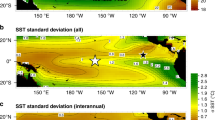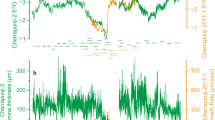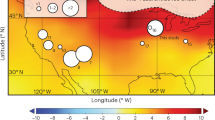Abstract
Earth’s interannual climate variability is dominated by El Niño/Southern Oscillation (ENSO). Palaeoclimate records indicate a lower ENSO variance during the middle Holocene compared with today1,2,3,4,5,6; however, model simulations have not reproduced the full magnitude of the changes7,8,9,10, and whether external forcing drives large intrinsic ENSO variability11 is therefore a matter of considerable debate. Here we present a 175-year-long, monthly resolved oxygen isotope record, obtained from a Porites coral microatoll located on Kiritimati (Christmas) Island, in the NINO3.4 region of the central equatorial Pacific. Our quantitative record of ENSO variability about 4,300 years ago shows that ENSO variance was persistently reduced by 79%, compared with today, and it exhibits a dominant annual cycle. Season-specific analysis shows that El Niño events were damped during their September–November growth phase, and delayed relative to the climatological year. We suggest that the higher boreal summer insolation at the time strengthened the tropical Pacific zonal winds as well as the gradients in sea surface temperature, and thereby led to an enhanced annual cycle and suppressed ENSO. As the weak ENSO is subject to interdecadal amplitude modulation, we conclude that amplitude modulation is likely to remain robust under altered climates. Our findings show that ENSO is capable of responding to external forcing.
This is a preview of subscription content, access via your institution
Access options
Subscribe to this journal
Receive 12 print issues and online access
$259.00 per year
only $21.58 per issue
Buy this article
- Purchase on Springer Link
- Instant access to full article PDF
Prices may be subject to local taxes which are calculated during checkout




Similar content being viewed by others
Change history
06 September 2013
In the version of this Letter originally published online, the published online date should have read '5 September 2013'. This has been corrected in the PDF and HTML versions of the Letter.
References
Tudhope, A. W. et al. Variability in the El Niño-Southern Oscillation through a glacial–interglacial cycle. Science 291, 1511–1517 (2001).
Moy, C. M., Seltzer, G. O., Rodbell, D. T. & Anderson, D. M. Variability of El Niño/Southern Oscillation activity at millennial timescales during the Holocene epoch. Nature 420, 162–165 (2002).
Woodroffe, C. D., Beech, M. R. & Gagan, M. K. Mid-late Holocene El Niño variability in the equatorial Pacific from coral microatolls. Geophys. Res. Lett. 30, 1358 (2003).
McGregor, H. V. & Gagan, M. K. Western Pacific coral δ18O records of anomalous Holocene variability in the El Niño-Southern Oscillation. Geophys. Res. Lett. 31, L11204 (2004).
Conroy, J. L., Overpeck, J. T., Cole, J. E., Shanahan, T. M. & Steinitz-Kannan, M. Holocene changes in eastern tropical Pacific climate inferred from a Galápagos lake sediment record. Quat. Sci. Rev. 27, 1166–1180 (2008).
Koutavas, A. & Joanides, S. El Niño-Southern Oscillation extrema in the Holocene and Last Glacial Maximum. Paleoceanography 27, PA4208 (2012).
Clement, A. C., Seager, R. & Cane, M. A. Suppression of El Niño during the mid-Holocene by changes in the Earth’s orbit. Paleoceanography 15, 731–737 (2000).
Liu, Z., Kutzbach, J. & Wu, L. Modeling climate shift of El Nino variability in the Holocene. Geophys. Res. Lett. 27, 2265–2268 (2000).
Zheng, W., Braconnot, P., Guilyardi, E., Merkel, U. & Yu, Y. ENSO at 6ka and 21ka from ocean–atmosphere coupled model simulations. Clim. Dyn. 30, 745–762 (2008).
Brown, J. R., Tudhope, A. W., Collins, M. & McGregor, H. V. Mid-Holocene ENSO: Issues in quantitative model-proxy data comparisons. Paleoceanography 23, PA3202 (2008).
Cobb, K. M. et al. Highly variable El Niño–Southern Oscillation throughout the Holocene. Science 339, 67–70 (2013).
Ropelewski, C. F. & Halpert, M. S. Global and regional scale precipitation patterns associated with the El Niño/Southern Oscillation. Mon. Weath. Rev. 115, 1606–1626 (1987).
Cane, M. A. The evolution of El Niño, past and future. Earth Planet. Sci. Lett. 230, 227–240 (2005).
Guilyardi, E. et al. Understanding El Niño in ocean–atmosphere general circulation models: Progress and challenges. Bull. Am. Meteorol. Soc. 90, 325–340 (2009).
Collins, M. et al. The impact of global warming on the tropical Pacific Ocean and El Niño. Nature Geosci. 3, 391–397 (2010).
Yeh, S-W. et al. El Niño in a changing climate. Nature 461, 511–514 (2009).
Cole, J. E., Fairbanks, R. G. & Shen, G. T. Recent variability in the Southern Oscillation: Isotopic results from a Tarawa Atoll coral. Science 260, 1790–1793 (1993).
Cobb, K. M., Charles, C. D., Cheng, H. & Edwards, R. L. El Niño/Southern Oscillation and tropical Pacific climate during the last millennium. Nature 424, 271–276 (2003).
Li, J. et al. Interdecadal modulation of El Niño amplitude during the past millennium. Nature Clim. Change 1, 114–118 (2011).
Braconnot, P., Luan, Y., Brewer, S. & Zheng, W. Impact of Earth’s orbit and freshwater fluxes on Holocene climate mean seasonal cycle and ENSO characteristics. Clim. Dyn. 38, 1081–1092 (2012).
Wittenberg, A. T. Are historical records sufficient to constrain ENSO simulations? Geophys. Res. Lett. 36, L12702 (2009).
Evans, M. N., Fairbanks, R. G. & Rubenstone, J. L. A proxy index of ENSO teleconnections. Nature 394, 732–733 (1998).
Torrence, C. & Webster, P. J. The annual cycle of persistence in the El Niño/Southern Oscillation. Quart. J. R. Meteorol. Soc. 124, 1985–2004 (1998).
McGregor, H. V., Fischer, M., Gagan, M. K., Fink, D. & Woodroffe, C. D. Environmental control of the oxygen isotope composition of Porites coral microatolls. Geochim. Cosmochim. Acta 75, 3930–3944 (2011).
Li, T. & Philander, S. G. H. On the annual cycle of the eastern equatorial Pacific. J. Clim. 9, 2986–2998 (1996).
Haug, G. H., Hughen, K. A., Sigman, D. M., Peterson, L. C. & Röhl, U. Southward migration of the Intertropical Convergence Zone through the Holocene. Science 293, 1304–1308 (2001).
Carré, M. et al. Mid-Holocene mean climate in the south eastern Pacific and its influence on South America. Quat. Int. 253, 55–66 (2012).
Timmermann, A., Lorenz, S. J., An, S-I., Clement, A. & Xie, S-P. The effect of orbital forcing on the mean climate and variability of the tropical Pacific. J. Clim. 20, 4147–4159 (2007).
Fowler, A. M. et al. Multi-centennial tree-ring record of ENSO-related activity in New Zealand. Nature Clim. Change 2, 172–176 (2012).
Smith, T. M., Reynolds, R. W., Peterson, T. C. & Lawrimore, J. Improvements to NOAA’s historical merged land-ocean surface temperature analysis (1880-2006). J. Clim. 21, 2283–2296 (2008).
Acknowledgements
We thank J. Bryden, T. Schambron and A. T. Berenti for support with fieldwork carried out under Permit from the Environment and Conservation Division, Ministry of Environment, Lands and Agriculture Development of the Republic of Kiribati. D. Zeko, J. Gaudry, A. Harbeck and S. Maher assisted with sample preparation. J. Abrantes is thanked for XRD analyses and thin-section preparation. J. Cowley, H. Scott-Gagan, J. Cali, A. McGregor, W. Lees and S. Sosdian assisted with oxygen isotope analysis. M. Dore, L. Glasbergen and H. Schofield assisted with Sr/Ca analysis. A. Wittenberg, J. Smerdon and R. Seager assisted with GFDL CM2.1 model output. M. Evans, N. J. Abram and T. J. Williams are thanked for thoughtful comments on the manuscript. We acknowledge the support of J-x. Zhao and funding from Australian Research Council (ARC) LIEF grant LE0989067 for MC-ICPMS U–Th dating. This work was supported by ARC Discovery Projects grants DP0664313 (C.D.W.), DP1092945 (H.V.M.) and DP063227 (M.K.G.), AINSE Awards AINGRA10077 (H.V.M.) and AINGRA09021 (H.V.M.), ANSTO ‘Cosmogenic climate Archives of the Southern Hemisphere’ and ‘Isotopes in Climate Change and Atmospheric Systems’ projects, and the National Computational Merit Allocation Scheme (S.J.P.). H.V.M. is supported by an AINSE Fellowship.
Author information
Authors and Affiliations
Contributions
H.V.M, C.D.W. and D.F. conducted fieldwork, sampled fossil coral XM35 and designed the study. H.V.M. oversaw all analytical aspects of the study, with contributions to δ18O analysis from M.K.G., age dating from C.D.W. and D.F., and Sr/Ca analysis from H.W. S.J.P. provided climate model output and analysis and assisted with the coral age model. M.J.F. and H.V.M. conducted the statistical analysis. H.V.M. and M.K.G. wrote the manuscript with assistance from M.J.F. All authors discussed the results, interpretations and contributed to the final version of manuscript.
Corresponding author
Ethics declarations
Competing interests
The authors declare no competing financial interests.
Supplementary information
Supplementary Information
Supplementary Information (PDF 5020 kb)
Supplementary Information
Supplementary Information (XLSX 144 kb)
Rights and permissions
About this article
Cite this article
McGregor, H., Fischer, M., Gagan, M. et al. A weak El Niño/Southern Oscillation with delayed seasonal growth around 4,300 years ago. Nature Geosci 6, 949–953 (2013). https://doi.org/10.1038/ngeo1936
Received:
Accepted:
Published:
Issue Date:
DOI: https://doi.org/10.1038/ngeo1936
This article is cited by
-
Greenhouse warming and internal variability increase extreme and central Pacific El Niño frequency since 1980
Nature Communications (2023)
-
Holocene hydroclimatic variability in the tropical Pacific explained by changing ENSO diversity
Nature Communications (2022)
-
Uncertainty of ENSO-amplitude projections in CMIP5 and CMIP6 models
Climate Dynamics (2021)
-
Changing El Niño–Southern Oscillation in a warming climate
Nature Reviews Earth & Environment (2021)
-
Modulation of late Pleistocene ENSO strength by the tropical Pacific thermocline
Nature Communications (2020)



